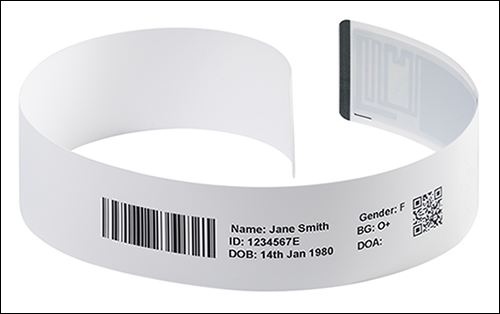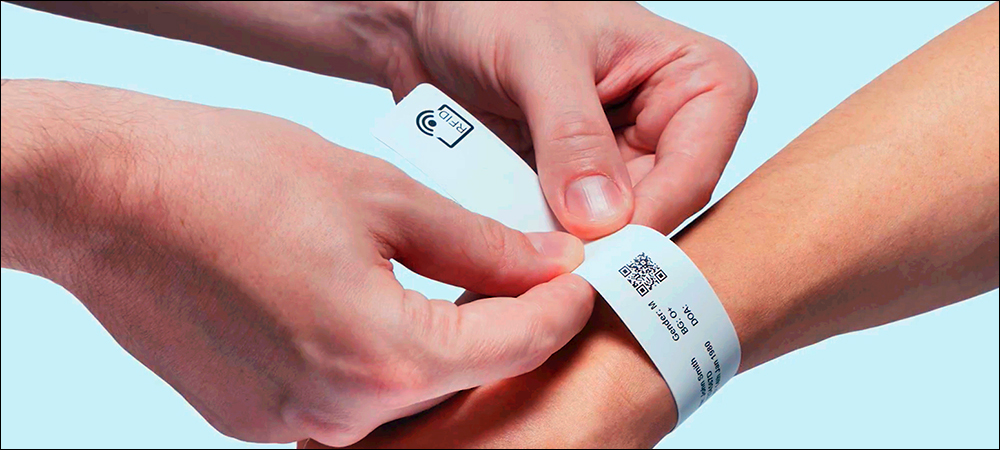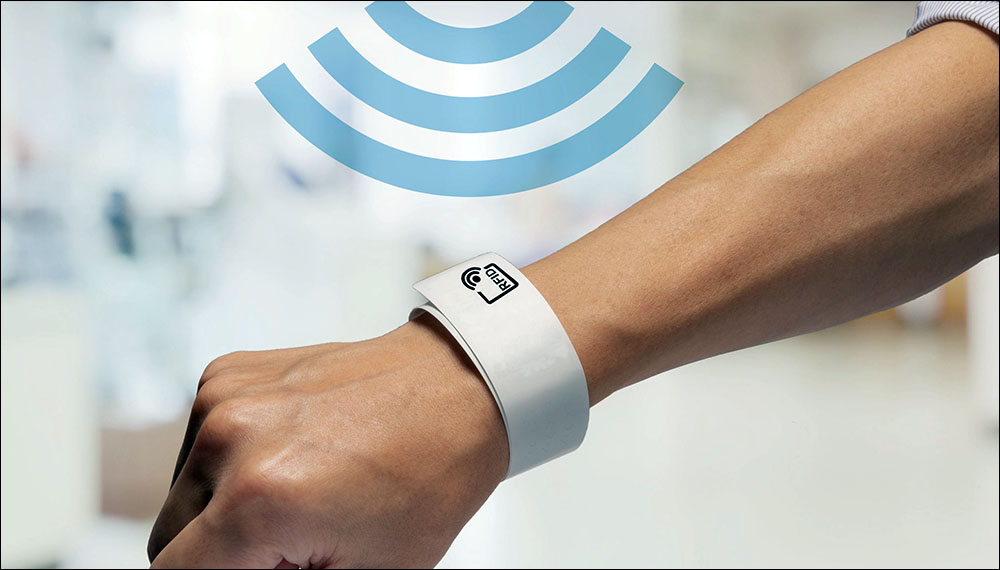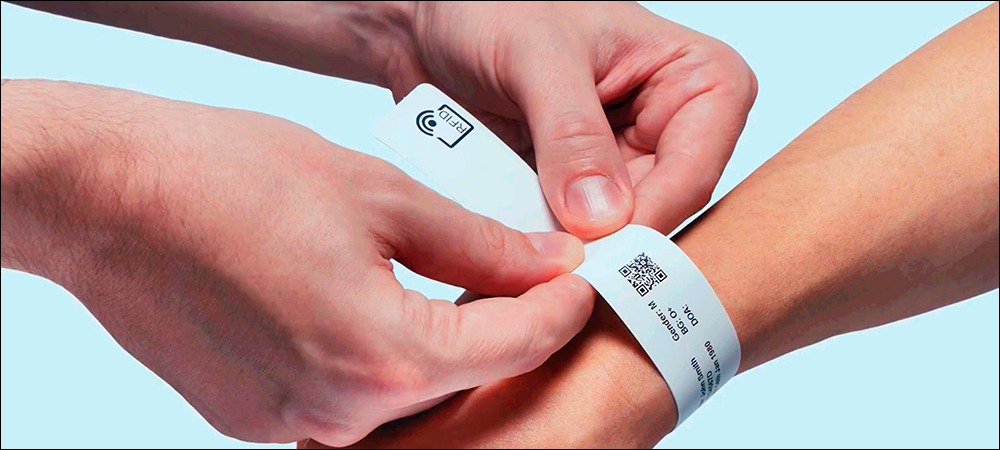After piloting a UHF RFID-enabled patient wristband for the past several months, a hospital in Switzerland is deploying the technology to identify patients and view their movements through its surgical area, in order to improve efficiency and reduce and leverage patient-flow information. The system consists of an RFID-enabled wristband that was developed and is being released commercially by SATO. The bracelet can be printed and encoded onsite as a patient is admitted, the company reports, and it can then track that individual’s location via a built-in RFID tag.
The system leverages SATO’s Application Enabled Printing (AEP) solution, including its 4-inch desktop printer and its direct thermal (DT) wristband. For typical deployments, technology partners provide middleware integration so each patient’s wristband can be automatically linked to that individual’s data in a hospital’s own software platform. SATO has declined to name the Swiss hospital, which it says was the first adopter during the early phase of the deployment.

SATO’s direct thermal wristband
SATO released the UHF RFID-enabled thermal wristband to automate the identification and location tracking of patients at healthcare facilities, according to Kevin Allart, the head of SATO’s global healthcare business. The company is now in discussions with several hospitals and care centers around the world to provide an RFID system designed to be affordable and easy to deploy, and to provide accurate reads at a distance of 2 meters (6.6 feet), the typical read range for overhead readers in doorways or corridors, or from handheld readers.
Hospitals have faced several challenges related to the use of wristbands employing barcodes or printed text, SATO’s customers have reported. One is a question of safety, the company explains, as healthcare providers come in close contact with patients, some of whom have transmissible diseases such as COVID-19, when viewing or scanning the barcode on their wristband. Another involves identifying patients without disturbing them—for instance, when they are asleep. Thirdly, Allart says, hospitals struggle with managing patient flow and do not know where a particular patient may be or might have been. This can lead to safety concerns, as well as inefficiency.
For the past 20 years, SATO has provided a barcode-enabled, printable wristband, says Motoaki Hirata, SATO’s manager of RFID international business development. “Most customers in the market recognize SATO as a printer manufacturer,” Hirata says, but during the past two years, many of its healthcare customers have requested a printable solution that would include automated identification. While there are existing RFID-based solutions for wristbands, he notes, most involve active technologies, with the bracelets requiring batteries, thus making them costly. “We were able to use the expertise we had in antimicrobial materials and printing, with an RFID label for a fully integrated product.”

UHF systems have posed some challenges regarding read range, Hirata explains. To solve this issue, SATO engineered the wristband with an extended “flag” to separate the antenna from a wearer’s wrist, thereby providing enough distance from the body for more reliable reads. SATO’s DT wristband was designed to transmit data at a range of 2 to 3 meters (6.6 to 9.8 feet), which the company says is optimal for accurate reads, using either a ceiling-mounted or handheld reader. Users employ SATO’s CT4-LX UHF printer to print each wristband as needed.
The system typically works as follows: When patients arrive for treatment at a hospital, their information is input and stored in the facility’s patient-management system. The administrator can then command the printer to print a wristband with a unique ID number linked to the patient’s data. The band consists of an antimicrobial material designed to be soft and comfortable, Hirata says. It is placed on the patient’s arm, with its RFID-embedded end positioned as the flag, raised above the wrist for better transmission—about 6 centimeters (2.4 inches). SATO uses what it calls the latest generation of integrated circuits available for the wristband.
The band can be used in a number of ways, the company reports. If a patient needs to be identified after entering a room or unit for safety and identification purposes, a healthcare provider can employ a handheld reader that is pointed within the 2-meter range from the patient’s RFID wristband, and the user could view that patient’s details without disturbing them or coming within close range. In many cases, hospitals look to further automate the collection of location data by understanding patient flow through key parts of their facility, without requiring the handheld scan. The Swiss hospital is employing overhead RFID readers installed above doorways, or on corridor ceilings.

Kevin Allart
The readers send interrogation transmissions that are captured by the wristband tags, and each response, containing the tag’s unique ID number, is captured by the reader. The device employs angle-of-arrival and received signal strength to identify the direction in which the bracelet, and thus the patient wearing it, is moving—either into or out of a room, for instance. If a wristband needs to be removed (for example, when an MRI test is being administered), the band is cut off the person’s wrist. The printer can then scan the bracelet’s barcode, enabling a new wristband with the same ID to be printed, and the previous band is discarded.
SATO says the hospital can use the wristbands to gain security data in real time. For instance, the software being employed with the bracelets can identify unauthorized patient movements, such as an individual entering or leaving an unapproved area. The reader would capture the tag ID, and the software would determine whether that person was permitted to enter or exit. If they weren’t, an alert could be triggered. The system was tested in a crowded, busy environment, with multiple individuals passing within range, moving in different directions. The results, Allart says, demonstrated that “any patient walking through at normal speed can be identified.”
Printers could be deployed at a hospital’s nurse stations, patient wards or admissions area. Most facilities would not be expected to issue an RFID wristband for every patient, due to the cost involved. Patients who do not need to be monitored as closely could use a lower-cost, barcoded wristband. Others, such as those in geriatrics or surgical areas, or who have COVID-19, could receive the RFID version. SATO is now making the system available globally and is in discussions with other hospitals throughout Europe and North America to deploy the wristbands at their facilities. “The wristband is designed to be used in any region,” Allart says, “including EU, North America and Asia.”

Motoaki Hirata
The type of data facilities hope to collect varies geographically, Allart explains. European hospitals have expressed an interest in data management so they can better understand patient flow and receive real-time alerts to allocate resources accordingly and reduce costs. “You have a lot of power when you extract the data from the readers,” he states. In the United States, on the other hand, some of the interest is initially focused on the safety of newborn infants, ensuring they are properly identified, and that no baby leaves the infant ward without authorization.
Additionally, Hirata says, the wristband’s RFID inlay is designed using an environmentally friendly manufacturing process. While standard RFID tags are built by etching an antenna into PET material, at SATO’s Japanese manufacturing site the antenna is manufactured using a method that does not produce hazardous solvents or waste liquids, and the aluminum waste from tag antennas is recycled.
Allart predicts the technology will initially relieve the staff of costly, time-consuming ID checks, but in the long term, he says, “I see the share of RFID wristbands growing” in the healthcare market. He envisions the bands being used for a variety of other services, such as patients paying for purchases with their bracelets or remotely managing their in-room TV. If sensors were linked to the bands, the system could identify if any patients suffered a fall, as well as monitor their vital signs. “What you have now is a good starting point,” in which SATO’s team is focusing on partnerships with integrators for patient-ID systems. “Then, in the coming years, our job is to go one step beyond.”



